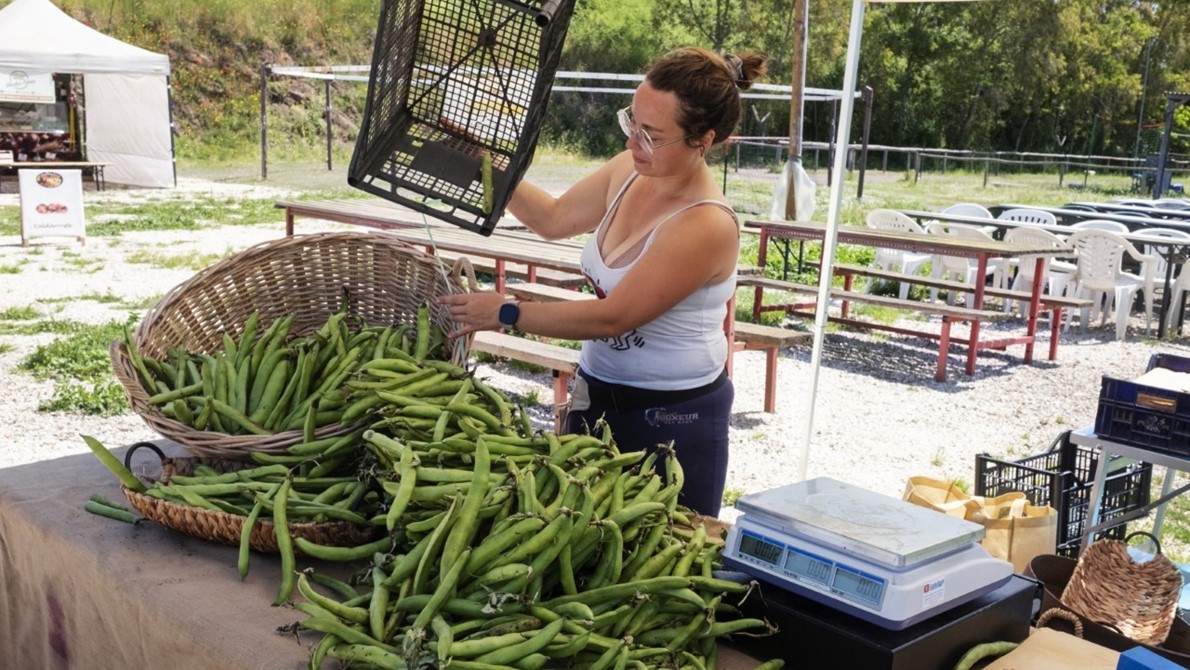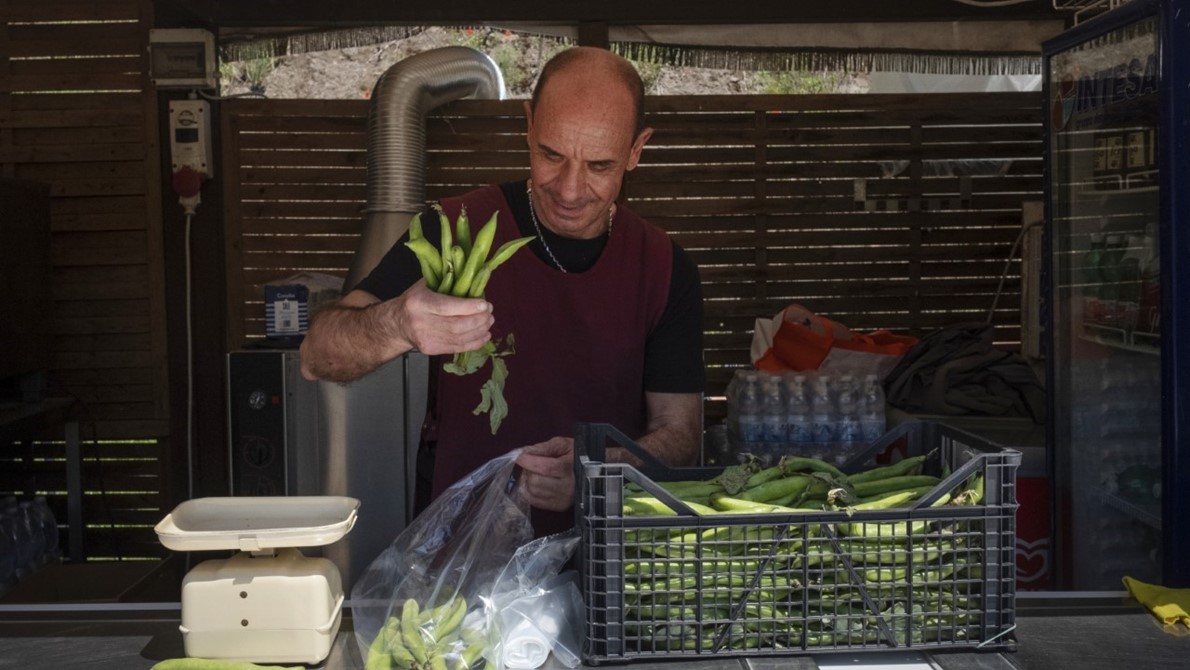As hungry Italians at the Festival for the Fava Bean lined up in a field in the Roman countryside to order fava and pecorino cheese, fava, and porchetta, cream of fava on top of pasta, or simply brown bags loaded with fresh fava, the manager of an adjacent garden spoke of the witch-fingered legume with dread.
اضافة اعلان
“We search for them and rip them out,” said Francesco Urso,
72, pointing at a sign that read, “The planting of Fava is banned.” The
leathery green pod bulging with indented oval beans may be delicious, great for
the soil, and a cherished Roman springtime snack, Urso said, but the issue was
one of life or death.
“Favism,” he said.
While many Romans celebrate the fleeting May fava season and
the coming of spring with fava-heavy picnics outside the city walls, sufferers
of favism live in fear. For those with the blood disorder — which Lucio
Luzzatto, a leading scientist in the field, said spread throughout the
Mediterranean, Africa, and the Middle East because it offered some protection
against malaria — exposure to fava beans can cause acute hemolytic anemia;
induce jaundice; enlarge the spleen; and prompt heart failure and death.
Around Rome this time of year, warning signs reading “In
this place fresh fava are served” are taped to restaurants and markets. The
near-death experiences of favism-afflicted celebrities go viral. “In the period
of the fava, be careful,” implored Ginevra Pisani, a television starlet who
described on her social media feed turning “completely yellow, green” and
fainting as her “red blood cells committed suicide.”
 Sara Autieri with fresh
beans to sell at the Festival for the Fava Bean, outside Rome on May 7, 2023.
Although favism, a blood disorder that can cause a violent reaction to fava
beans, lurks throughout Italy, many Romans look forward to May, when the
legumes are in season.
Sara Autieri with fresh
beans to sell at the Festival for the Fava Bean, outside Rome on May 7, 2023.
Although favism, a blood disorder that can cause a violent reaction to fava
beans, lurks throughout Italy, many Romans look forward to May, when the
legumes are in season.
“And I thought they were good for you, these fava,” she
added bitterly.
Many Italian towns have introduced ordinances banning the
cultivation of fava beans within hundreds of meters of schools or the homes of
the vulnerable, as some favism sufferers say a mere whiff of the insidious fava
pollen can set off an attack.
Sardinia, the southern Italian island where about 10 percent
of the population has favism, with the number hitting 13 percent in the south,
has developed some remedies over the years.
“To heal me when I was little, they laid me down and put me
up to my face in ox crap,” said Beatrice Brundu, 78, from the small Sardinian
town of Perdasdefogu. “And it cured me. Now, they just give me pills.”
But despite the prevalence of the disease, fava beans are
unavoidable throughout Italy, especially in Rome in May. They tangle in fresh
market crates, freshen up dishes laden with guanciale, simmer in the beloved
vignarola fresh vegetable stew. (“It’s May 1,” announced a server at Osteria la
Gensola in Rome. “We have a rigatoni alla vignarola.”) They are also, according
to the city government’s Fava and Pecorino page, “tied to the ancient usage of
the commemoration of the dead.”
Still, in May, the fava bean, bursting and green, is a sign
of life.
At the Roman trattoria Da Felice, wine-and-sun drenched
diners ordered pasta with fava beans, peas and guanciale as Cesare Murtas, a
manager who is from Sardinia, looked on beside the front door’s
beware-of-fava-beans sign. “My son has it,” said Murtas, 52, referring to the
disorder. He said he had taught his son from an early age to stay away from the
beans. “He wears dog tags that say he has favism in case he gets into a car
accident.”
Fava, one of the oldest cultivated crops stretching back to
at least 6,000 BC, has long been a source of protein and anxiety across the
region.
Greek philosopher Pythagoras, father of the a² + b² = c²
theorem, considered the fava a symbol of death. He is said to have preferred to
risk fatally facing his enemies rather than run into a field of fava. His cult
of vegetarian geometry enthusiasts believed that the fava bean held the souls
of the dead, or that their hollow stems provided elevator service up from
Hades.
Ancient writers also suggested that they disliked fava
because they resembled genitalia or a fetus, or because they caused flatulence,
which drained the breath of life. Or, as Scientific American put it, because
they “believed a chewed bean smelled like the blood of a murder victim when
left in the sun”.
The hundreds of Romans at the fava festival last Sunday, in
Castel di Leva, knew what they wanted. Downy green mountains of discarded fava
pods stacked up on long wooden tables like science-fair volcanoes. As Romans
shelled and inhaled the beans, there wasn’t a warning sign at the fair. “It’s a
Festival of the Fava,” said event organizer Francesco Galli, 47. “If you’re
allergic, maybe don’t come.”
 Fresh beans are bagged for
a customer at the Festival for the Fava Bean, outside Rome, May 7, 2023.
Fresh beans are bagged for
a customer at the Festival for the Fava Bean, outside Rome, May 7, 2023.
At one table, Carmelina Antonini, 74, loaded the empty pods
into her bag. “Nothing gets thrown out,” she said, telling her dubious husband
and friends that she would boil them and then fry them with garlic and hot
pepper.
She and her friends compared notes about people they had
known who had favism (“he got an anaphylactic shock”), and she recalled that it
was once a cause for discharge from the military service.
“Why?” asked her friend Emilia Cucci, 77. “Because the army
was picking fava beans?”
Cucci then recalled a traumatic incident when she was served
fava beans — meant to be tender and buttery — that were instead “as hard and
small as a pebble,” leading her to launch them in protest.
Lately, she said, that while free of favism, she worried
that she suffered from some other mysterious allergy that led her to “sneeze
four, five, six times”.
“Who knows?” her husband interrupted.
“I’m talking,” she said. “Maybe it’s the husband.”
A few yards away, Sara Lauteri, 29, a fava vendor, stood
behind heaping piles of pods, advertising how they were “super fresh, picked
this morning.” She stuffed them into brown bags for customers and said no
favism sufferer had ever been reckless enough to approach her.
“Their red globules practically explode,” she said.
Paola Romani, 59, nodded in agreement.
“It’s a nasty disease — it takes you by the throat,” she
said. Then she opened a pod, popped some beans into her mouth, and bought a bag
to go with her brick of pecorino. “May,” she said with a shrug, “is fava”.
Read more Lifestyle
Jordan News







